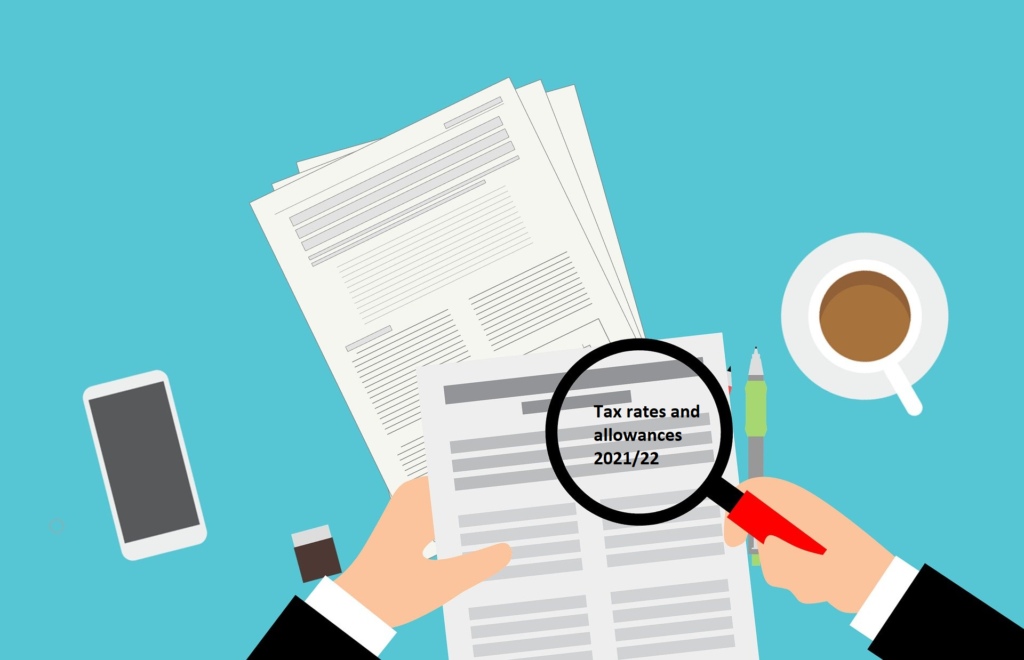With a new tax year come the new tax rates and allowances. Although there has not been a great significant change in the rates and allowances for 2021/22 compared to 2020/21, the government has announced that a lot of the tax rates will be frozen till 2026. This is due to the pandemic and the current state of the economy because of it.

So here are the main small business tax rates and allowances for the tax year of 2021/22.
Corporation Tax
- You have to pay 19% Corporation Tax if your profit falls below £300,000.
- If your annual profit exceeds £300,000 then you have to also pay a 19% Corporation Tax. You can find out more in our corporation tax guide.
- This will remain the same until 2023/24 where the percentage will increase from 19% to 25%. There will be a small profits rate at 19% (which will mean that businesses with a profits of £50,000 and under will only pay 19%. The 25% will be applied to businesses with the higher threshold of 250,000.
Value Added Tax (VAT)
- You have to register for VAT if your turnover over the past 12 months is £85,000 or more.
- The de-registration threshold is £83,000.
Dividend Tax
- Tax on dividends is paid at a rate set by HMRC on all dividend payments received.
- Anyone with dividend income will receive £2,000 tax-free, no matter what non-dividend income they have.
- Dividend basic rate is 7.5%. £49,999 on taxable income over the Personal Allowance in England.
- The dividend higher rate is 32.5%. £50,000 on taxable income over the Personal Allowance In England
- Dividend additional rate is 38.1%. Over £100,000 of taxable income.
Income Tax – Personal Allowance
- The personal allowance (the amount you can earn before any income becomes taxable) is £12,570.
- You will not receive a tax-free personal allowance at all if you earn £125,140 or more.
Income Tax Bands
- The basic rate band is 20% and applies to income of up to £50,270.
- The higher rate band is 40% and applies to income from £50,271 to £150,000.
- The upper (additional) rate band is 45% and applies to income of £150,000 and above.
National Insurance Contributions (NICs)
- If you run a company (or work for one), then Class 1 NICs apply.
- Employees’ Class 1 NICs are payable at 12% on salaries received over £183 per week.
- Employers’ Class 1 NICs are payable at 13.8% on earnings above £169 per week.
- For sole traders and partnerships, you pay Class 2 and Class 4 NICs.
- Class 2 NICs are payable at £3.05 per week and are paid by anyone earning £6,515 or more through self-employment during the tax year.
- Class 4 NICs are paid on profits you make as a self-employed person. The Class 4 NIC rate is 9% of annual profits between £9,568 and £50,270, and an additional 2% on profits above £50,270 per year.
- Read our guide on National Insurance for further information.
Pensions Savings Tax Relief
- The annual allowance limit remains at £40,000.
- The maximum tax-free lump sum is 25% of your pension pot.
Pension Auto-Enrollment Rates
- You have to pay 8% (3% minimum contribution from employer and 5% contribution from employee) on salaries ranging from £6,240 – £50,000.
Individual Savings Accounts (ISAs)
- The overall ISA investment limit remains £20,000.
Capital Gains Tax
- If you pay higher rate income tax you’ll pay 28% on your gains from residential property, and 20% on your gains from other chargeable assets.
- If you pay basic rate income tax you’ll pay 18% on your gains from residential property, and 20% on your gains from other chargeable assets.
- You’ll pay 10% if you’re a sole trader or partnership and your gains qualify for Entrepreneurs’ Relief.
- Each individual has an annual CGT exemption of £12,570 (personal allowance).
Capital Allowances
- The Annual Investment Allowance (AIA) increase to £1,000,000 from 1st January 2019 – 31st December 2020.
- First-year allowances remain at 100%.
More on small business tax rates and small business tax rates and allowances for 2020/21.


Follow Company Bug